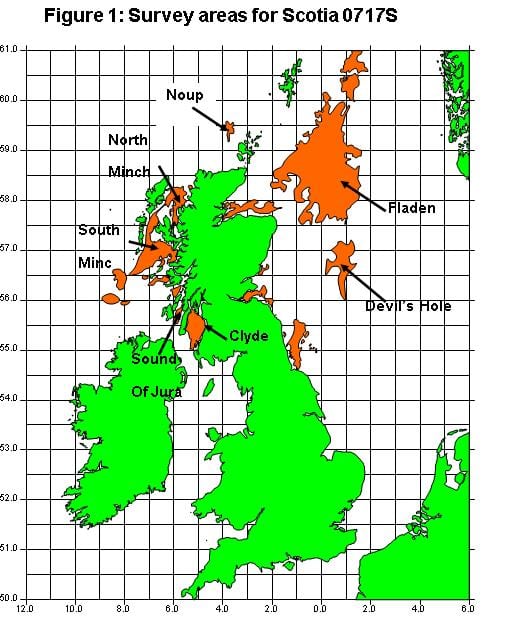Marine
Latest update from the MRV Scotia survey 0717S – the 7th of the year
June 15, 2017 by Marine Scotland Communications No Comments | Category Marine Directorate general, Marine Directorate Science, Marine Directorate Surveys
Gear onboard:
2 x Scotia BT175 80mm prawn trawls
2 x Day grabs and 1 x sieving table
2 x towed UWTV sledges
2 x 600m umbilical towing cables and associated TV equipment (including back up)
Objectives
- To obtain estimates of the abundance and distribution of Nephrops burrow complexes at Fladen, in the North Minch, the South Minch, the Firth of Clyde, in the Sound of Jura and at Devil’s Hole.
- To use the TV footage to record the occurrence of other benthic fauna as well as evidence of commercial trawl activity.
- To collect sediment samples at each station.
- To obtain samples of Nephrops for size composition analysis.
- To collect samples of Nephrops from the trawls for comparison of reproductive condition and morphometrics in each of the different survey areas (Functional Units).
- To record and retain marine litter obtained from trawling as part of the MSFD.
Procedures
The main areas in which the survey will take place have been surveyed on annual basis for a number of years and are shown in Figure 1. A combination of two approaches will be used to derive the survey positions: a stratified random approach and fixed stations. The majority of stations will be generated by employing the traditional stratified random technique based on sediment distribution in all areas except the North Minch, where stations will be randomly generated within the boundaries of commercial Nephrops fishing effort, obtained from Vessel Monitoring System (VMS) data. Alternatively, at the Devils Hole, as well as within some of the other survey areas, deployments will be carried out at a number of fixed sites.
Weather permitting, it is planned that the vessel will first carry out a training session in deploying the sledge en route to the Fladen grounds. Initially approximately 450m of the TV cable will be paid out with a large buoy attached to the end of the cable to be lowered into the water. This will add back tension to the cable on recovery, creating tighter turns on the winch and reducing the potential for damaging the cable. The sledge will then be attached to the umbilical to carry out a training session where the sledge will be shot, approximately 100 m of cable paid out and then recovered. When this procedure is completed to the satisfaction of all involved, the vessel will then progress to the first of the Nephrops burrow TV stations at the SW edge of the Fladen ground. Once the work at Fladen has been completed, the vessel will then steam to the west coast and to begin surveying stations in the North and South Minches.
It is anticipated that the vessel will work south along the western side of the Minches towards the Clyde, surveying TV sites and carrying out trawls as required.
The survey will continue on into the Sound of Jura, followed by the remaining South and North Minch stations whilst working north.
At each TV station a video camera mounted on to the sledge will be towed along the seabed for approximately ten minutes at approximately 1 knot and in to the tide – the ship’s dynamic positioning will be required for this. Nephrops burrows observed, individual Nephrops and other benthic fauna will be recorded onto DVD for analysis. The depth and distance travelled by the sledge, as well as camera height from the seabed, will be recorded automatically. Where practical sediment samples will be taken using the mini van Veen grab mounted on the sledge.
Update from Adrian Weetman, the Scientist in Charge
Scotia left Aberdeen in the morning of 6th June 2017 and headed out to Fladen to begin the annual Underwater TV Survey. Over the following few days, 70 stations were surveyed and one trawl was carried out in generally, favourable conditions. Some technical difficulties were experienced during this time which were either resolved or alternative arrangements made. These problems, as well as a storm through the night of the 7th which restricted TV operations, initially resulted in delaying the survey, but good progress was made over all and in the early hours of Monday the 12th the vessel began the journey west. En route, Scotia made a port call at Scrabster, where the workboat was put ashore to collect replacement parts for one of the faulty systems onboard. With the engineers working hard to repair the faults, the vessel continued west arriving at the first station in the North Minch in the early evening of the 12th. The survey continued working south down the west side of the North Minch with few issues and was off Harris by 10:00 the following morning, and completed the North Minch leg mid afternoon later that same day. After a three hour steam south work began in the South Minch in the evening of Tuesday 13th and continued working south towards Barra during the 14th, in worsening weather conditions.
Further Information



Leave a comment